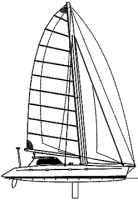Mathers 57
Multihull cruiserr
The most obvious feature of this beautiful design is the cabintrunk location. By moving the cockpit forward, the crew and helmsman are moved out from behind the imposing bulk of the deckhouse. Visibility is now unrestricted and sail controls can be conveniently led to winches at the base of the mast. The aft cockpit area is now smaller and is reduced to a "back porch" for socializing.
The hulls are long and skinny for speed. Beam has been pushed to 30 feet. The bridgedeck or "slam pan" clearance is around 36 inches. The D/L of this design, based upon the designer's light displacement of 22,000 pounds, is 78.57 (using a DWL of 50 feet). But I will note that this displacement is labeled "light." "Light ship" weight studies are of academic interest and are only valid as a necessary step on the way to a weight study of the boat in an operable condition. Boats need crew and fuel. The drawings show the transoms clear of the waterline with about 28 inches of overhang aft, but the photos show the transoms immersed with the boat at rest.
If you consider that it takes about 950 pounds to immerse each hull an inch, I would guess-timate that this cat is floating about 5,000 pounds (average 4 inches) heavy. In fact, this situation appears compounded by the fact that 2.5 feet were added to the stern beyond the original designed lines. Presumably this was an effort to get some counter and lift the transom clear of the water. Cats do get heavy aft. This would raise the D/L to 90.86 using a DWL of 51 feet to account for the immersed counter.
Cat interiors are challenges. You have two skinny tunnels to fill with sleeping accommodations connected by a small meeting hall. Berths will fill the beam of the hulls, which pushes the berths into the ends. The volume left in the center portion, between the berths, can be used for lockers, heads and, in this case, a workbench. Note that the engines are located below the workbench. Note also how the daggerboards are tucked into the head areas.
The galley is huge and looks perfect to my eye. Note the counter space each side of the range and the sink. This is often lacking in monohull galleys. The nav station is also huge and includes inside steering. I don't like the long, skinny dinette. I like to sit across from my guests and look at them while we eat, drink and visit. In this case, you would have to pull out some folding chairs. But considering that you are not going to heel, this is certainly no hardship.
Using the designer's displacement, the SA/D is a whopping 30.07. The rotating wing mast was engineered and built by Gold Coast. Rotating masts give the mainsail a beautiful shape and can greatly improve performance.
Gold Coast's construction methods included a composite approach using both foam and wood cores. The wood cores were both balsa in the Dura-core configuration in the topsides and old-fashioned Douglas fir strip planking in the bottoms for durability. The decks use Core-Cell foam. The bridgedeck uses 2-inch Nida-core honeycomb panels in glass skins.
This is a well-crafted design and an unusually handsome boat. I am sure we will be seeing more of Mr. Donovan's impressive work.

Comments